Contents |
Branch Retinal Vein Occlusion and Central Retinal Vein Occlusion
Introduction and Overview
We are reminded daily to live a healthy lifestyle, including a good diet and lots of exercise, but we don’t usually associate the risks associated with not doing so with the loss of our eyesight.
During a comprehensive vision examination, an eyecare practitioner will view the inside of the eye to look for any unusual changes there, especially concerning the circulatory system and the tiny arteries and veins that carry oxygen and nutrients to the tissues of the retina. It is fascinating to consider that what the circulatory system is doing elsewhere in the body, it is also doing in the eye, and that the view of the inside of the eye allows the only direct view of the arteries and veins without the need for surgery. If there are problems with the circulatory system in general, the effects will be evident in the eye.
Normally, the retina is nourished by the oxygen and nutrients brought to it by the arteries and the depleted blood is then drained away by the veins. When a vein has been blocked for some Reason the blood will build up and cause bleeding and swelling in and around the retina.
A blockage in a vein located within the eye is called a Branch Retinal Vein Occlusion (BRVO). When the central retinal vein is blocked, the drainage to the entire eye is affected; this is called Central Retinal Vein Occlusion (CRVO). The only difference between the two is the location of the blockage and the area that can be damaged, either just the part of the retina served by that particular branch or the entire retina if the central vein is blocked. However, even in a branch vein occlusion, blood and fluid can leak from the vessels and interfere with vision in the entire eye.
Risk Factors
Patients at risk for BRVO or CRVO may have one or more of the following:
- Hardening of the arteries (arteriosclerosis)
- Plaque formation in the arteries (atherosclerosis)
- Diabetes
- Hypertension (high blood pressure)
- Inflammation of the veins (vasculitis)
- Use of certain medications such as oral birth control containing estrogen, or hormone replacement therapy
- Some rare blood disorders that cause a greater-than-normal tendency for the blood to clot.
Ocular Complications
The extent of the damage and the visual symptoms that result depends on the size of the blocked vein and its exact location. For example, if the blockage happens in the outer part of the retina, symptoms may be barely noticeable, but if it occurs near the central part of the retina, especially around the macula, vision is much more likely to be reduced or distorted.
About one in five patients that have a BRVO can develop a further complication in the form of the growth of new blood vessels around the blockage called neovascularization. Neovascularization sounds at first like it might be a good thing, but because the new vessels are extremely fragile and may easily break, they usually only add to the problem of excess blood in the eye.
The vision is blurred and distorted because of the swelling and leakage into the eye of blood and fluid.
Treatment
The eyecare practitioner looking into the eye at a BRVO (or CRVO) will usually see a lot of bleeding, swelling and leakage of blood and fluids into the normally clear vitreous humour and ocular tissues. However, most of this will resolve on its own over the course of a month or more, much as a bruise under the skin would disappear over time. The fluids are gradually re-absorbed into the circulatory system and carried away. (A bruise, in fact, is caused by bleeding and swelling under the skin, which is what causes the discoloration associated with it.)
In much the same way, vision loss may also return over time. The blocked vein may come unclogged on its own, or nearby vessels may contribute to returning normal circulation.
In cases where neovascularization is seen, laser photocoagulation to prevent new vessel breakage and bleeding is indicated.
In the long term, there is no particular way to speed the healing process, although Kenalog (triamcinolone acetonide, made by Bristol-Myers Squibb) injection has been used successfully to improve the visual prognosis in BRVO, CRVO and macular edema arising from various other causes.
Prognosis
While a branch retinal vein occlusion may look to an eyecare practitioner to be much more serious than a branch retinal artery occlusion, the visual outlook is usually much better in the former. Even without treatment of any kind, the fluids and blood will usually be reabsorbed and resolve on its own.
However, frequent vision examinations to be sure that retinal neovascularization or macular edema is not occurring are essential. In addition, systemic circulation factors such as those noted above in the list of risk factors should be monitored and treated by the patient’s primary care physician. Treating the underlying causes is important for both general health and for prevention of further occlusions.






